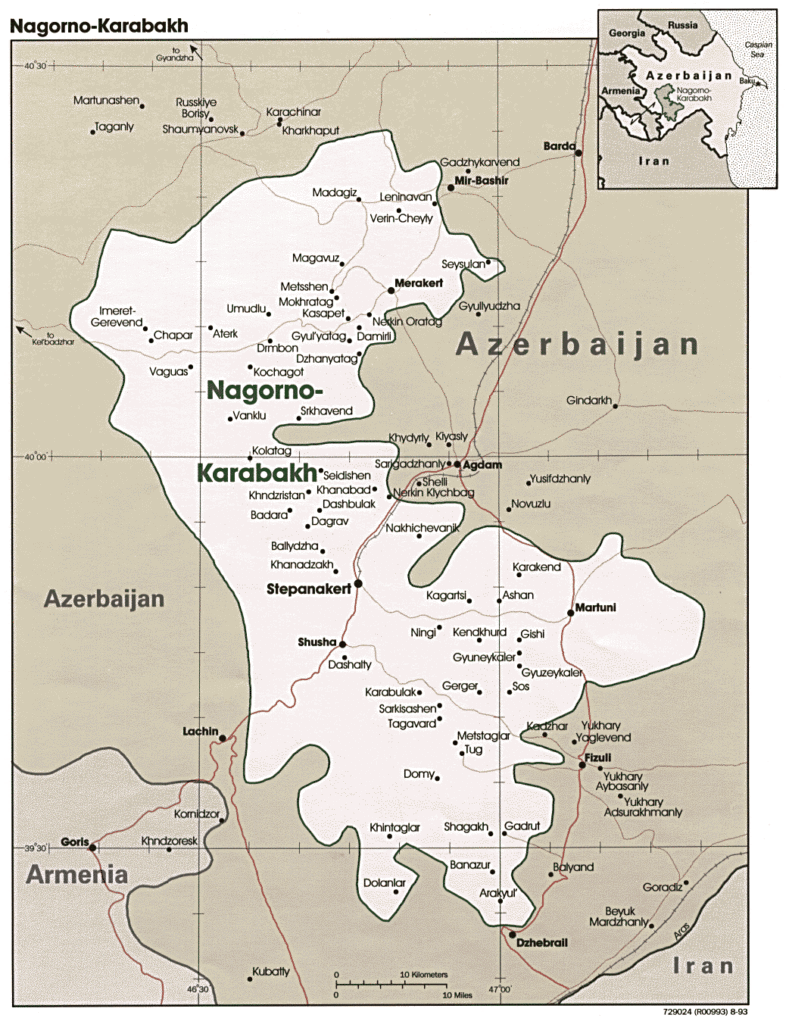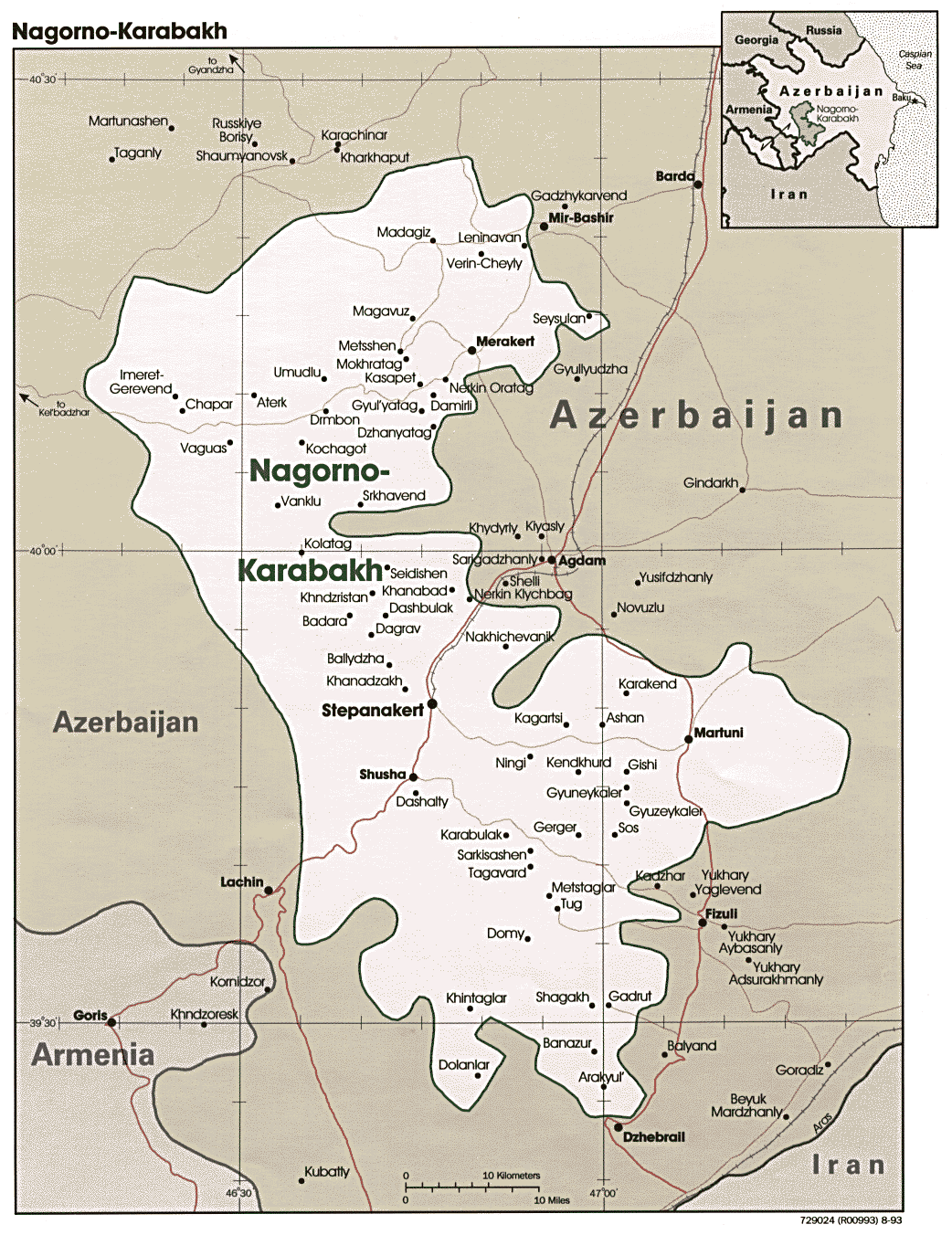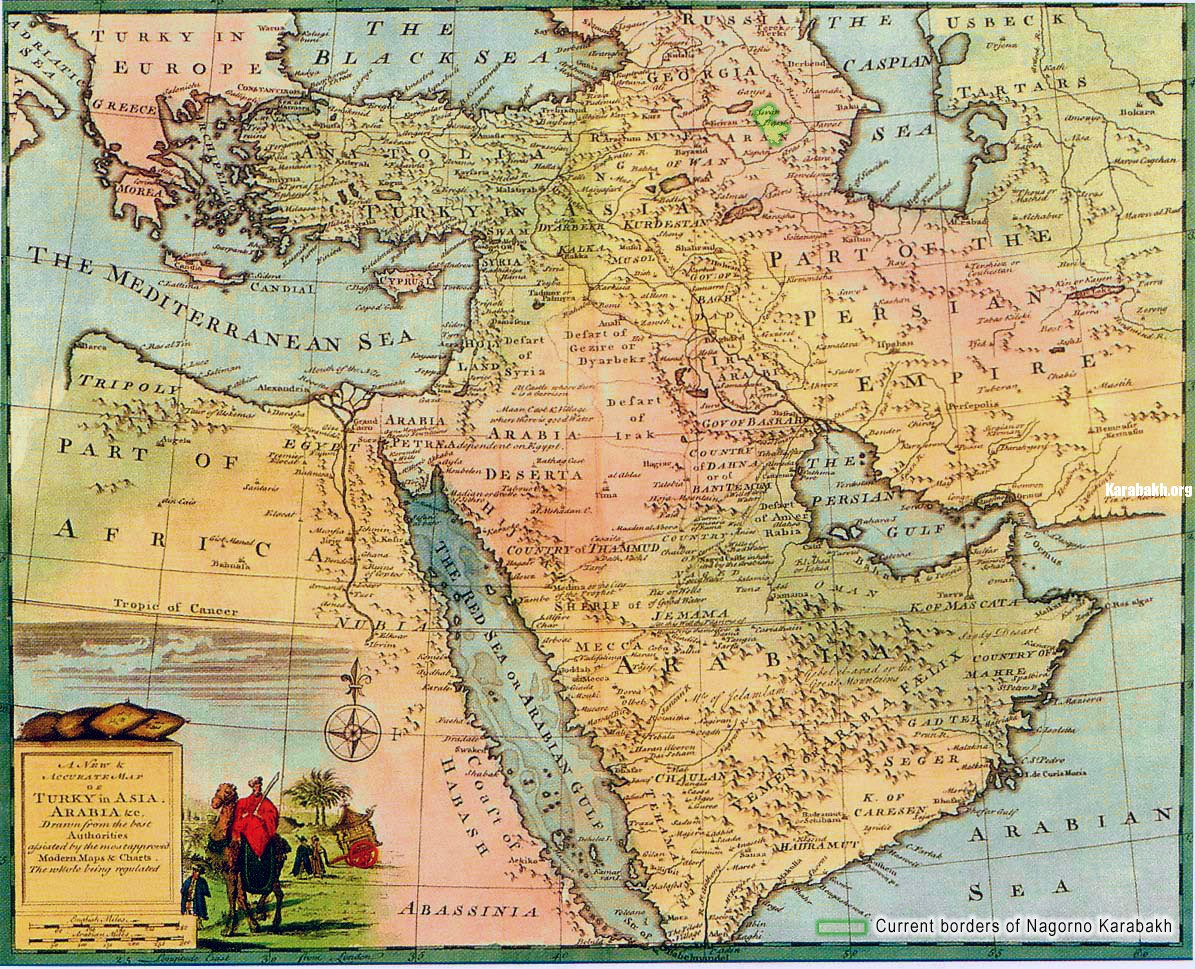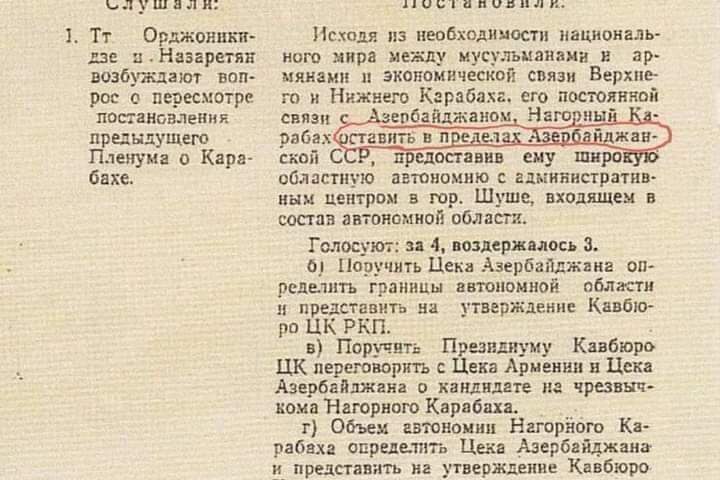Though, the question of Karabakh’s belonging to Azerbaijan was solved, serious disagreements emerged during the discussion of the concrete forms of the autonomy and its borders. To the contrary of the Armenian communists, the Azerbaijanian communists, headed by Narimanov, didn’t want to separate Karabakh and to hold ethnic segregation between the Armenians and the Azeris.
On September 26, 1921 the Karabakh issue was discussed again in the Politbureau and Orgbureau of the CC AzCP with participation of Narimanov, Kirov and others. Taking into account the complexity of the socio-political, cultural and economic aspects of the Karabakh issue this session adopted a decision: «To request the Kavburo to review its decision about detaching he Mountainous Karabakh, and not to declare the autonomy until that»[6].

The final solution of the issue was delayed till summer 1923. On June 1923 the Presidium of the Central Committee of the AzCP adopted a new decision: «To consider detaching Karabakh, both upland and lowland, to one administrative unit»7. However, such decision didn’t satisfy some Armenian communists. They, headed by the chairman of the Azerbaijan Trade-unions Soviet, member of the special commission on Karabakh L.I. Mirzoyan, posed the issue in the Transcaucasian Comittee (Zakkraykom) of the RuCP, which «advised» the Central Committee (CC) of the AzCP to establish autonomy on only the mountainous part of Karabakh. On July 1 the Presidium of the CC AzCP had to change its recent decision and decreed: «To request the AzCEC [i.e. Central Executive Committee] to decree (on behalf of the Presidium) the autonomy of the Mountainous Karabakh, having created from it an Autonomous Karabakh region with center in Khankendi and with the executive committee in the head»[8].
At this time, as a result of «cleansing» there was left no influential Azeri-communists, who could hamper this hidden Armenian policy aimed and its division and depersonalization of Azerbaijan. Narimanov was effectively distanced from Azerbaijan after being elected to the CEC of the USSR, where, in fact, he had no real influence to the events in Azerbaijan. All the real power in Azerbaijan was concentrated at the hands of the Russian and Armenian communists (Kirov, Mirzoyan and others).
On July 7, 1923 the special commission on Karabakh hold a session, which decided to create a regional administration with center in Aghdam, consisted of the lowland parts of the Karabakh districts, left from the detachment of the Mountainous Karabakh.[9]
On the same day, there was published the decree of the CEC of the AzSSR «On establishment of the autonomous region of the Mountainous Karabakh». The decree said: «…Azerbaijan Central Executive Committee of the Soviets decrees: To create from the Armenian part of the Mountainous Karabakh an autonomous region as a constituent part of the Azerbaijan SSR with center in Khankendi [it was soon renamed Stepanakert, after Stepan Shaumyan, «great Armenian Bolshevik» of the Baku commune];
The organs for administration of the autonomous region will be the regional executive committees (ispolkoms) and the local communes (sovety)»[10].
On July 16, 1923 the Presidium of the Central Committee of the AzCP decided to include some lands of the Skobelevsky community and the town of Shusha, inhabited by Azeris, to the MKAR too. Soon afterwards, the special commission defined the border between the mountainous and lowland Karabakh.
From the first years the Mountainous Karabakh Autonomous Region (MKAR) was established, there were conducted considerable reforms in the economic, social and cultural spheres. Along with Ganje and Nakhichevan, Karabakh was defined, as the region of priority tempos for industrialization in the republic. Special attention was paid to the firm observance of the proportionality of the national composition of all the elective organs with the population’s ethnic composition in the region. Thus, in 1925-1926 Armenians constituted 89.5 % of the population of MKAR, Azeris- approximately 10%, Russians- approximately 1%, and in the Central Executive Committee Armenians constituted 88%, Azeris–11%, and Russians- 1%.[11]
Thus the «Karabakh issue» was solved positively, in favor of the Armenian population of Karabakh, which was granted autonomy within the frontiers, in which it constituted the majority. Speaking in the VI congress of the AzCP in 1924 the head of the Azerbaijan SSR Kirov said: «…We finally have solved this issue [i.e. Karabakh] and, undoubtedly, have done a good work. No doubt, that, in the whole, we will not have to re-decide this issue, again»12.
Despite this, the «Karabakh issue» arose again in autumn 1945, right after the end of the World War II. At that time, the Soviet Armenia’s leader Arutyunov brought the issue of transfer of MKAR to Armenia in the highest instance in Moscow (the Central Committee of the All-Union CP). In his letter on this occasion, Arutyunov claimed, that MKAR’s incorporation into Armenia «would assist greatly its development and would better the administration of the economy». Arutyunov also argued that with MKAR’s incorporation the Armenian SSR would get more specialists from the Karabakh region.
Upon receiving Arutyunov’s letter the former secretary of the Central Committee of the All-Union Communist Party Malenkov sent inquiry to Azerbaijan’s Soviet leader of the time Baguirov requesting to inform about his opinion on this suggestion from the Armenian communist party. When replying to this inquiry, Baguirov declined all the arguments in Arutyunov’s letter, but at the end, diplomatically, expressed his consent to incorporate MKAR into Armenia (excluding the Shusha district, inhabited by Azeris), but with condition that three regions of the Armenian SSR adjacent to Azerbaijan and inhabited mainly by Azeris to be transferred to Azerbaijan.13 But this couldn’t satisfy not only the Armenia, but also Moscow. Thus, the Armenian claims didn’t succeed this time.
However, after this diplomatic defeat, the Armenian leaders understood what a big obstacle was the Azeri population of Armenia on the way of their expansionist plans. They, with Mikoyan in the head, convinced Stalin of the necessity to allow resettlement of the Armenians from abroad to the Armenian SSR, and by the way, suggested to solve the housing problems that might occur with regard to this process by resettlement of the Azeris from Armenia to the few-populated regions of Azerbaijan.
On December 23, 1947 there was adopted a decree of the CEC of the USSR «On the resettlement of the collective farmers and other Azeris from the Armenian SSR to the Kura-Araz lowland of the Azerbaijan SSR». According to the decree, it was planned to resettle «on voluntary principles» 100,000 people. The Armenian leadership have demonstrated a special zeal in carrying out of this task and resettled more than 150,000 people (according to some other sources approximately 240,000 people) from Armenia to Azerbaijan. Thus, the Armenian leadership achieved its goal to considerably diminish the number of the Azeri population in Armenia. Now, it was important to wait patiently a favourable moment to set forth territorial claims against Azerbaijan again.
These claims were set forth in 1963 as well, when some Armenian political circles, having used the squabbles inside the communist party which came as a result of Khruschev’s destalinization policy, gave Moscow a petition on behalf of 2,500 Karabakh Armenians, which claimed, that allegedly, Azerbaijan doesn’t pay enough attention to the economic development of the Mountainous Karabakh and hinted towards MKAR’s transfer to Armenia. At that time, Moscow not wishing to aggravate the situation and also considering the fact, that many economic indices of the MKAR didn’t lag behind, and in some cases, even exceeded the average standards in the republic,14 ignored this message. Nevertheless, violence erupted in the Mountainous Karabakh in 1963 and in 1968, the victims of which became approximately 20 people. But at that time the Soviet power was strong enough to suppress and prevent such actions. In many cases, these events were not reflected even in the local newspapers, and the clashes didn’t spread beyond those narrow limits in which they had erupted.
In the second half of the 1980s, with beginning of the Gorbachev’s era of Perestroika and Glastnost, «the Karabakh issue» became topical in the Armenian political circles again. In August 1987 the Academy of Sciences of Armenia prepared one hundred thousand-strong petition requesting to annex MKAR and Nakhichevan AR to the Armenian SSR. This petition was followed by meetings in Yerevan, which began in October 1987 and which were hold under demand of «reunification» («Miatsum») of Mountainous Karabakh and Nakhichevan with Armenia. In November of the same year Gorbachev’s advisor on the economic affairs A. Aganbekyan when giving an interview to the French newspaper «L’Humanite» expressed «his own point of view», that, allegedly, the Mountainous Karabakh would be soon transferred to Armenia. Thus, the passions over the Karabakh issue continuously grew up.
Soon it became clear that the artificial «union of the brother-peoples»- the USSR is not ready to the impetuous global changes, which passed beyond the limits of Perestroika and slipped away from the central government’s control. This «giant with clay legs» couldn’t exist with freedom of speech and the dissolution of the USSR got an irrevocable form. As it happened before, in condition of crisis of the existing system, and the lack of clear outlines of a new one, along with the national-liberation movements, the nationalistic tendencies began to grow. Already, by January 1988 the first wave of refugees from Armenia reached the capital of Azerbaijan Baku. Similar to the dissolution of the Soviet Union, the Armeno-Azeri conflict got more and more irrevocable character.
- Id. reserves1, inventory 74, folder 123, list 118/ Id. p. 13;
- Id. reserves 1, inventory 74, folder 132 list 110 / Id. p. 14;
- Id. reserves 1, inventory 74, folder 132, list 146 / Id. p. 15;
- Id. reserves 1, inventory 74, folder 132, list 170 / Id.
- «Baku worker» (Bakinsky rabochi) newspaper July 9, 1923 / Id.
- «Karabakh» op. cit. [21] chapter VII, p. 138;
- Id. 137 / also: I. Aliyev Nagorno-Karabakh op. cit.[20] p. 88;
- [Azerbaijan Communist] Party Archive [PAAF IML] reserves 1, inventory 169, folder 249, lists 3-6a / also: I. Aliyev Nagorno Karabakh p. 89;
- With regard to the economic development, the Mountainous Karabakh Autonomous Region (MKAR) really leaved behind many other regions of Azerbaijan, particularly the neighboring regions of Karabakh not included into MKAR.
For example, involvement of the labor resources in the various sectors of economy in 1987 was 74 % in the whole territory of Karabakh (i.e. including the Lachin, Kelbajar and other regions of the Lowland Karabakh), whereas this figure was 85 in only MKAR.
MKAR had got 36% of the industrial potential for producing consumer goods, albeit the autonomous region occupied only 25% of the territory of the whole Karabakh region and only 21% of the Karabakh population lived in MKAR (of them 25% Azeris).






